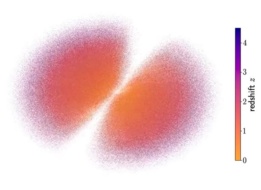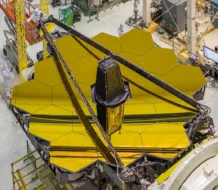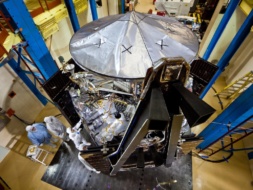NASA’s Perseverance rover is currently trekking through an ancient river delta on the Red Planet, searching for signs of life.
As it journeys through the great rocky wasteland, here and there, the rover is taking small samples of Mars rocks a few centimeters deep and storing them in little metal tubes. But our favorite little Martian traveler may not be digging far enough to find the markers of extant life on the Red Planet.
Biomolecules are organic molecules that are integral to some biological processes, and include lipids, proteins, carbohydrates, and nucleic acids. In the upper layers of Martian regolith, biomolecules are probably too distorted by millennia of constant UV radiation to be identifiable these days. Hope remains, though, for those signs of life that could reside a meter or two beneath the surface.
A study published last week in Science Advances exposed seven kinds of biomolecules and some extreme environment-loving organisms to a harsh, Mars-like radiation environment on the side of the ISS for a year and a half.
The researchers at the German Aerospace Center (DLR) found that even when exposed to prolonged Martian-ish levels of radiation, certain biomolecules remained intact enough to be identifiable. Plus, a little protection beneath layers of rock and dust went a long way to keep the biomolecules in shape.
Measuring the remains: The study’s researchers used a Raman spectrometer, which can suss out the structure of individual molecules. Raman spectrometers are used widely in mineralogy to reveal chemical bond structures. Best of all? This is the instrumentation that Perseverance is currently using.
“We got a number of results where we were really able to see that some of the selected biomolecules are detectable, and some of the organisms are also still alive,” Jean-Pierre de Vera, the principal investigator on the project, told Parallax.
So, scientists still see a glimmer of hope in the search for signs of life on Mars. “The experts say, ‘Okay, these molecules cannot be stable with this kind of radiation you’ve had outside the atmosphere for years,’” said de Vera. “‘They must be completely destroyed.’ But they were not completely destroyed.”
Our robot helpers
As we speak, Perseverance is sticking to its mission on the faraway surface of Mars. Though researchers might be out of luck if they’re looking for biomolecules in the top few centimeters of Martian regolith, it’s possible the rover will strike gold with other signs of life, such as fossilized remains. We won’t know for sure until the mid-2030s, when NASA and ESA plan to bring the samples home for more detailed study.
Drill baby drill
For a better shot at finding biomolecules, researchers will have to look deeper.
ESA is currently planning its own Mars rover mission, ExoMars, that will be able to drill two meters into the rocky surface to gather samples that have been better protected from UV radiation. The Europeans hoped to launch the mission this year, but ExoMars’s timetable—and future—now hangs in the balance. Roscosmos had been the mission’s launcher, and since Western payloads aren’t flying on Soyuz rockets, ExoMars doesn’t have a ride to space.
Looking further: The investigation is not yet done, according to de Vera and Mickael Baqué, lead authors of the paper. Their first experiment lasted a year and a half—a far cry from the billions of years of radiation that have bombarded the surface of the Red Planet. Follow-up studies will attempt to model biomolecule degradation over much longer stretches of time, figuring out just how deep our robots might have to dig to find a pristine sample.




